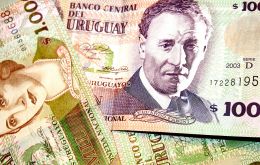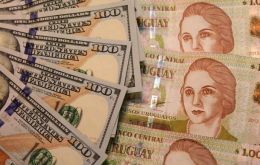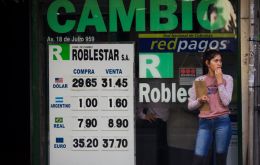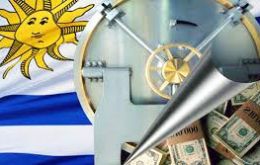MercoPress. South Atlantic News Agency
Tag: Uruguayan peso
-
Thursday, August 10th 2023 - 11:25 UTC
Uruguay Peso, most overvalued currency against US dollar says the Big Mac Index

The Uruguayan Peso is turning out to be one of the most overvalued currencies (out of 52 surveys) against the US dollar. In other words according to the Big Mac Index, the US dollar is cheap in Uruguay and well below what is considered the long term “equilibrium point”.
-
Wednesday, June 29th 2022 - 23:39 UTC
Uruguayan peso keeps growing against US dollar

While the Argentine peso keeps losing ground against the US dollar, just the opposite is going on across the River Plate, where the Uruguayan currency is stronger every day, having undergone a 12.4% appreciation so far this year.
-
Wednesday, March 30th 2022 - 09:51 UTC
Uruguayan exporters concerned over waning currency exchange

The Uruguayan Exporters Union (UEU) Tuesday expressed its concern through a statement in light of a waning exchange rate between the local peso and the US dollar, which has reached its nadir for the past two years, thus adding to the “uncertainty” and “volatility in international markets.”
-
Wednesday, January 20th 2021 - 01:27 UTC
IMF: Uruguay advances important reforms amid the pandemic

By S. Pelin Berkmen, Dmitry Gershenson, Luis Herrera Prada, and Jose Torres - Despite the ongoing crisis, Uruguay is taking important steps to address preexisting macroeconomic conditions and lay the foundation for a more resilient, competitive, and stable economy.
-
Thursday, September 24th 2020 - 09:31 UTC
Argentine currency worthless in Uruguay

For the second day running the Argentine Peso was virtually worthless in neighboring Uruguay foreign exchange houses. On Tuesday the Argentine Peso was worth zero, and on Wednesday there was a modest ten Uruguayan cents offered for the battered Argentine currency.
-
Wednesday, March 27th 2019 - 20:54 UTC
Dollar rises in Uruguay while tension increases in Argentine markets

In Uruguay, the dollar traded at noon on the state bank Banco Republica (Brou) board at $ 33.20 for the purchase and $ 34.60 for the sale, 45 cents above the close price on Tuesday. On the board of private exchanges, the currency to the public came to sell at $ 34.80 and $ 34.90.
-
Wednesday, May 9th 2018 - 20:19 UTC
US Dollar rises: Uruguay behind Argentina

After several days up in Argentina, the devaluation of the Argentine peso and the rise of the US dollar have had some impact on the other side of the River Plate, where the exchange houses of downtown Montevideo marked on Wednesday the value of the currency up to 31,70 Uruguayan pesos per dollar, a rise of 2.08% compared to Monday —the highest in five years—. For the Uruguayan government, the country follows the global trend and calls for calm, beyond the noise generated in Argentina, which is beginning a dialogue between the Finance Minister, Nicolás Dujovne, and the International Monetary Fund (IMF) in Washington.
-
Wednesday, September 23rd 2015 - 07:17 UTC
Uruguay pumps greenbacks to keep the US dollar rate on sliding stability

Uruguay's central bank was forced to sell almost 65 million dollars on Tuesday, the highest volume so far this year, to keep the US dollar from ballooning as fears of the collapse of the Brazilian economy are felt through the region. The dollar finally ended trading with a slight 0.12% increase at 28,826 Pesos to the greenback.
-
Saturday, July 5th 2014 - 09:13 UTC
Uruguay's inflation index for June slightly down: 9.08% in twelve months

Uruguay's inflation index experienced a slight deceleration during the twelve months to June, from 9.18% in May to 9.08%, basically because of cheaper fresh food, frozen public utility rates including fuel, while a stabilized exchange rate for the US dollar with a strong Peso, helped with imported goods.
-
Monday, December 2nd 2013 - 19:49 UTC
Inflation and competitiveness, Uruguay's main challenges for next year and a slower growing economy

Inflation and competitiveness are the two main macroeconomic challenges faced by Uruguay and does not anticipate an easy 'soft landing', at 3% growth rates in coming years, according to Deloitte during a conference on “Prospects for 2014 and economic challenges for the next government”.
